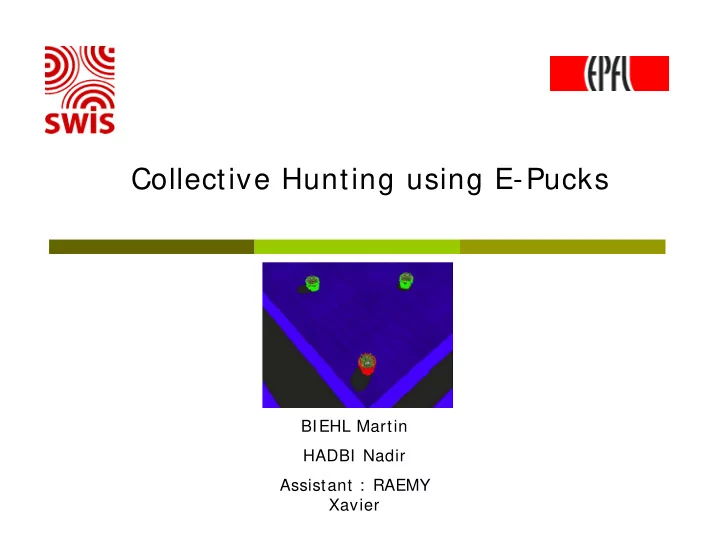

Collective Hunting using E-Pucks BIEHL Martin HADBI Nadir Assistant : RAEMY Xavier
Goal of the project � Simulation of two « predators » and a twice as fast prey in a bounded arena… � Only solution to catch the prey ? � Collaborate ! � We explored two ways of collaboration : � Observing the behavior of other predators and prey -> « Image processing » (like wolves for ex.) � Information exchange -> Wireless communication
Image Processing � Simulated in « Webots » � To facilitate image processing: « Perfect World » : Predators are green, Prey is red, Arena is blue
Strategy Some examples of situations…
Searching (no com)
Following (no com)
Following (no com)
Following (no com) Sees other predator in front, and follows him
Following (no com) ∆ x distance travelled between two Waits for his camera shots leader to take a turn i.e. ∆ x surpasses a minimum value
Turning (no com) Starts spinning in Leader turns place in when prey direction changes of his direction leaders turn.
Turning (no com) Starts spinning in place in direction of its leaders turn, until prey and predator are out of sight… …and a little longer to get good results. (CRUCIAL POINT)
Trapping (no com) Then it starts straight into the final direction.
Trapping (no com)
Trapping (no com) Maybe its a successful trap …
Trapping (no com) …maybe not. In this case the trapping predator sees the prey pass by in front of him and thus he starts following it.
Relay of following task (no com) …maybe not. The formerly following robot now sees the other one in front of him and follows him.
Trapping (no com) And turns …traps … follows …
Problem (no com) Will spin in wrong direction, because he depends on his partners movement.
State Machine (image processing)
Wireless Communication � Emitter/ Receiver communication system with ideal range � Relay � No longer dependent on the movement of the other predators
Searching (with com)
Following (with com) States are constantly One predator broadcasted. will see the prey first. And follow it.
Trapping (with com) States are constantly broadcasted. Knowing there already is a follower, the other predator now follows the prey and decides to turn and trap depending on the preys behaviour. ( ∆ x)
Relay of following task (with com) States are constantly broadcasted. Again we relay the following task to the formerly trapping predator.
Following (with com) States are constantly broadcasted.
Following (with com) States are constantly broadcasted.
State Machine (communication)
Results How efficient is our algorithm ? Does the � collaboration work ? Scalable ? -> Compare it to others controllers : Random Predators a) 2 followers b) 2 anticipators c) Specialist predators ( 1 follower + 1 anticipator ) d)
Results Predators with comm vs 2 anticipators �
Results � Comm Robots vs No-Comm Robots
Conclusion � Scalability : ? � Limitations : � Implementation to real robots -> Image processing, communication -> Noise ! � Further improvements � GA to find optimal parameters � Behavior of the prey � Wider arena
Recommend
More recommend